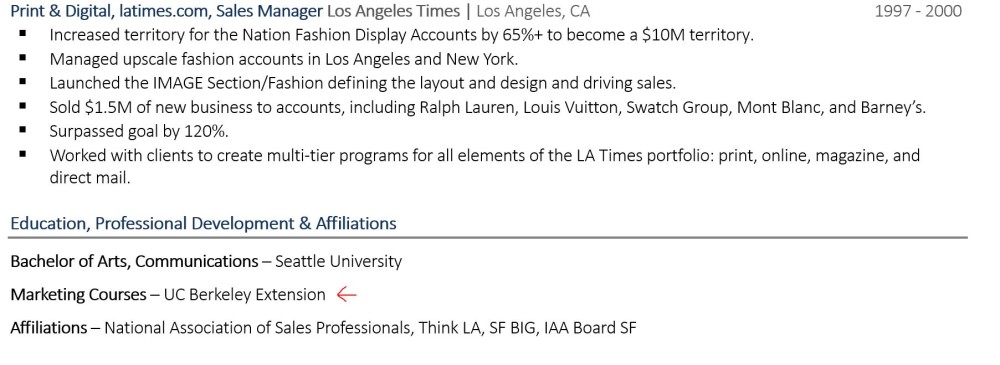Continuing Education on Your Resume (Examples and Tips)

8 min read

The job hunt is a competitive landscape. For a mid-level corporate job opening, a recruiter receives an average of 250 resumes. Because of this, it’s really important to find ways to stand out from the rest of the hiring pool. Showing professional development on a resume is always a plus. Professional development is a great way to earn a promotion or even get a raise, which is why learning how to list continuing education on a resume is so important.
The most common form of professional development involves enrolling in continuing education courses. If you’ve participated in such courses, or are planning to, then you absolutely want to include that information on your resume. In this post, we'll show you where and how to list continuing education on your resume!
What is continuing education?
Continuing education is a program, training, or additional course that expands upon or introduces new ideas that relate to your professional role. Depending on the company you work for, you may be required to take continuing education courses in order to maintain your license in your profession.
Many fields require continuing education courses or professional development opportunities. This helps professionals touch up on their knowledge and stay up to date on the newest developments and subject matter expertise in their industry. This can include things like new regulations, systems, and other changes within the industry.
Some industries that may require continuing education are:
Teachers
Insurance professionals
Interior designers
Interior architects
Lighting designers
Architects
Engineers
Emergency management professionals
School administrators
Educators
Nurses
Mental health professionals
Psychologists
Social workers
Project management
Professional writers
Continuing education is typically measured in units - Continuing education unit (CEU) or continuing education credits (CEC). They can be taught at colleges or government employment offices, as well as led by licensed agencies.
How to list continuing education on a resume
You would usually list professional development and continuing education under the "Professional Development" section.
Reserve the "Education" section of your resume for your most grand academic achievements, like degrees and licenses.
The “Professional Development'' section of your resume would typically be one of the last sections in that document. However, some industries highly value professional development courses. Academics, medical, and IT are all industries where the applicant should consider having their “Professional Development '' section more prominent so it captures the reader’s attention quicker.
You can also use a different title or a combination title like Education and Professional Development.
Listing continuing education on your resume is simple! Here is how it's done:
Step #1
Decide exactly which continuing education and professional training you want to include on your resume. Anything you list should be relevant to the position you're applying for.
For example, taking online courses in marketing would not be included on your resume if you were applying for an accounting position. Listing irrelevant information on your resume will potentially weaken your resume by discouraging a recruiter from continuing to read through it. .
Step #2
List your continuing education and any other relevant information.
List the courses taken, the name of the program and issuer, and other relevant information. If you completed the course, you can also list the year.
Some professional certifications for continued education will give you a cert or reference number upon completion. Depending on your industry, it might be important to include this number.
You should also provide the issuing agency. There might be preference given to the curriculum of one agency’s program over another. Providing this information can give you a leg up.
Example of continuing education on a resume:
Education, Professional Development & Affiliations
Bachelor of Arts, Communications – Seattle University, 2020
Marketing Courses – UC Berkeley Extension, 2018
Affiliations – National Association of Sales Professionals, Think LA, SF BIG, IAA Board SF, 2017
Notice how in the above example, the items are listed in reverse chronological order. If you have a certification that is highly important for a job, but it was achieved years ago, you can instead order your certification by relevance.
Here is the same list, but written in a proper resume format.

Notice how in the above example, the dates of completion were left off completely. This can be encouraged for certifications that are older than five to ten years. The reason for this is that professional development is all about relevance. The whole point of pursuing it is to keep your skills up to date with current market trends in your industry. If you completed continuing education courses fifteen years ago, the content of what you learned might not even be applicable today.
However, if you are certain that the knowledge is still relevant, you can include the course name and issuer; just omit the year you completed it. This approach also shows a potential employer that you are willing and capable of pursuing your own professional development as you move through your career.
Learning how to list continuing education on a resume helps with career advancement
While continuing education is required for many industries, some continuing education is voluntary and could help give you a leg up on other candidates when applying for a job.
Continuing education can even include online courses on your resume. Just make sure it's relevant to whatever position you're applying for before listing it on your resume. Online courses can be found for free or for the cost of tuition, and usually provide you with a certification at the end which you can include on your resume and LinkedIn profile.
It can also allow you to get promoted faster or even be offered a higher salary. Professional development of any kind will help you progress in your career. Employers love to see a candidate who is committed to learning and progressing within their industry or role because it shows loyalty, commitment, and tenacity.
Where to find continuing education courses
Some industries will provide you with all of the information and registration needed for your continuing education courses. That is typically the case when a company or industry requires courses from their staff.
In these situations, be sure to properly sign in to the course because you will be sent confirmation of your credit hours, which usually need to be forwarded to your employer. If you work for a school district, for example, when you arrive at your training site, you will be asked to sign in and indicate how many hours of continuing education you need. Once fulfilled, your school district record will be updated and will actually remain in the system even beyond your current position. When you go to apply for a new position, you will be able to reference your record of professional development to increase your value as a candidate.
If you are independently pursuing continuing education courses at jobs where your employer does not require them, then you have a plethora of options available to you! Websites like Lynda, Coursera, Udemy, and LinkedIn Learning all offer continuing education certifications to support your professional development.
When you browse the list of courses available, keep in mind the relevance of the information being taught. If you are hoping to change careers or advance in your current career, you can use these professional development courses to help guide you. If you don’t have the required experience necessary to land a certain role, having experience through your continuing education courses can be a great way to show a recruiter that you do have the foundations down.
How to list continuing education on a resume: quick tips and takeaways
List the most important items first. This is what the employer will see first so be sure that the most important items are listed first.
Include the year only if you completed continuing education you're listing within the last 5-10 years – otherwise don't include the date.
We mentioned this before and we'll mention it again: don't list irrelevant information on your resume. This includes continuing education that has nothing to do with your industry or position.
Summary
Many industries require continuing education for educational and workforce needs, but you can also choose to further your education on your own. Including professional development opportunities like continuing education on your resume can really help you stand out from the pool of candidates. It shows recruiters that you are determined to achieve excellence in your field and that you understand how trends can affect skills and professional knowledge. It can also help speed your career progression and land you a bigger salary. If you are feeling stuck in your career, consider continuing education courses.
Not sure how to list continuing education on your resume? Have your resume reviewed by a professional resume writer today – for free! Click here.
Recommended reading:
This post was written in 2018 and has been updated to reflect our current style guidelines and more up-to-date career advice.

Written by
Emma Elizabeth, Resume Writer, Emma Elizabeth, Resume Writer
Emma is a certified employment specialist with over 6 years of experience in career mentorship and employment training. With an affinity for technical writing, Emma is passionate about developing training, policy, and procedure manuals. In 2020 she helped design Colorado’s first state-certified training program for people with disabilities entering the workforce.
